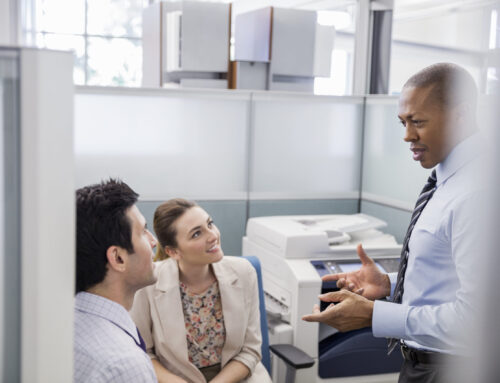The printer you choose for your office is more than just a business tool. It’s an investment. Compared with other technologies, the humble printer has fundamentally changed little in recent years, increasing in efficiency while decreasing in cost. Still, the market is vast, and deciding which all-in-one office printer is right for your needs may seem daunting. We’re here to tell you it doesn’t have to stay that way. Here are the factors to consider and questions to ask that’ll help you narrow down your options and make the best decision.
The All-in-One Office Printer
Electronics have converged over the years, cramming more functionality into fewer devices. Why buy two items when one can do the same job? The all-in-one printer is no exception. Most come with the ability to print, scan, and copy files. Some can also fax files, though this feature is becoming increasingly obsolete. When choosing your printer, it boils down to a question of how well each of these functions performs and how much you need them. Let’s look at some of these features.
Inkjet vs. Laser Printing
Inkjet printers make use of cartridges to apply ink directly to the page by use of a mobile printhead. This head has a long lifespan and will save you on maintenance in the long run. Though they have a reputation as slower printers, the inkjet printer has been able to up its speed to compete with its laser counterpart over the years.
The cartridges for your inkjet printer are grouped into black on one hand and cyan, magenta, and yellow on the other. Basic inkjet printers will have all of the colored tones in one cartridge, while more advanced ones will split them up. Unfortunately, if one toner runs out, you won’t be able to print. That said, cartridges are cheaper than replacing toners in a laser printer.
In all, inkjet printers offer a reliable, affordable, and smaller-scale printer that gets the job done. However, as your company grows or printing needs increase, an inkjet might become too slow for comfort. That’s where laser printers start to shine.
Laser printers use a rolling drum and static electricity to apply powdered toner to paper. These drums need to be replaced relatively often, so your maintenance will be higher. Upfront, they are also more expensive. However, when factoring in higher output, speed, quality, and extra functionality, it more than makes up for it.
Though large-scale color laser printers are more accessible than they used to be, many can’t match the quality of inkjet printing. The ones that do are going to cost you.
Scanning and Copying
The other two major features of an all-in-one office printer depend on the type of printer you buy. Inkjet printers use the scanner to scan and copy documents one at a time, whereas larger laser printers can use trays and the scanner to do both. This significantly cuts down on time.
Speed
Smaller printers tend to be slower, with a moderate output of 10-20 pages per minute (PPM). Inkjet printers will be slower in general. On the other hand, a large laser printer can output anywhere between 40-60 ppm.
Duty Cycles
This is how many pages a printer can print in a month before running into mechanical errors like smudging and jamming. Inkjet printers tend to fall into the lower range at about 1000 pages per month, while higher-end laser printers can manage as much as 15,000.
Per-Page Pricing
Another stat printers are often measured by is their price per page (PPP). You can often find this number on the manufacturer’s website. Laser printers fare much better in this category.
Software
Many all-in-one printers come with their own software. In these cases, you might need to go through a few more hoops to use the printer, even if you need it for a simple task. Some printers don’t come with software, apart from the drivers, and can integrate seamlessly with your existing network and software layout.
Efficiency
A printer that consumes more power and wastes less paper will save you and the environment. A printer’s energy efficiency is often mentioned on the manufacturer’s website. Many higher-end printers can also print double-sided pages automatically, which can speed up printing and save on paper.
Connection
Some printers are wireless, enabling any network device (including some smartphones) to connect to them, while smaller printers are often cable-bound to a local area network or single PC.
Touchscreen Capabilities
While most modern printers come with LCD screens, some smaller ones rely on buttons to input commands. This can get quite frustrating when remembering combos. A faster and more direct option is to have touchscreen LCDs on your printer.
Some office printers also offer the opportunity to send scanned documents to email accounts, cutting down the time you have to spend attaching the files yourself.
Questions to Ask When Deciding on an All-in-One Office Printer
Now you’ve seen all the major features of these printers, you need to decide what matters to you. When weighing up the pros and cons for your office, it may help to ask questions like these:
How Much Am I Looking to Print?
Smaller monthly outputs may mean that you can save by buying a smaller inkjet printer. Most laser printers only start being cost-effective at higher outputs.
Monochrome or Color?
Apart from the most expensive laser printers, inkjet printers will often do a better job with higher-quality color images. Keeping it in black and white also means keeping things cheaper, no matter the printer.
What Am I Using It For?
A small firm printing out spreadsheets or simple documents won’t require the same quality as an advertising studio printing out full-color concepts. You need to figure out if you need a lot of decent prints or a lower number of stellar ones.
What Am I Willing to Spend on Upkeep?
As a rule, higher-output printers need part replacement more often. When things do go wrong, a more advanced all-in-one office printer costs more to repair. Small inkjet printers can go for years without needing parts replaced.
What Is the Size of My Office?
Not only will this affect the size and speed of the printer you buy, but also its connectivity. Do you need your printer to be wireless and easily integrated into the existing network?
Make the Right Choice
Hopefully, you’re all set to ask the right questions when investing in your all-in-one office printer. But you may still be looking for some extra expert advice. At Kelly Office Solutions, we’ve been providing over 70 years of expertise to customers in Winston-Salem, Greensboro, Charlotte, and other areas in North Carolina.
Why not use our extensive knowledge of office printing solutions to help you make the best decision possible? We’re ready to help you. Contact us today.






Leave A Comment
You must be logged in to post a comment.